Welcome to the exciting world of Oranda Goldfish care. These pets bring beauty and peace to your home aquarium. I’m here to help you set up the perfect environment for these elegant fish.
Oranda Goldfish are truly a result of beautiful selective breeding. They have a unique egg-shaped body and a special wen on their head. This wen grows into a wonderful feature, showing off their beauty. They can grow up to 8-9 inches, some even bigger. This shows their good health and the space they need.
These goldfish do well in the right environment and can live 15-20 years. Knowing the right tank setup is key for your Oranda Goldfish’s health. Let’s start this adventure and make sure our fish friends have a great life.
Discovering the Unique Charm of Oranda Goldfish
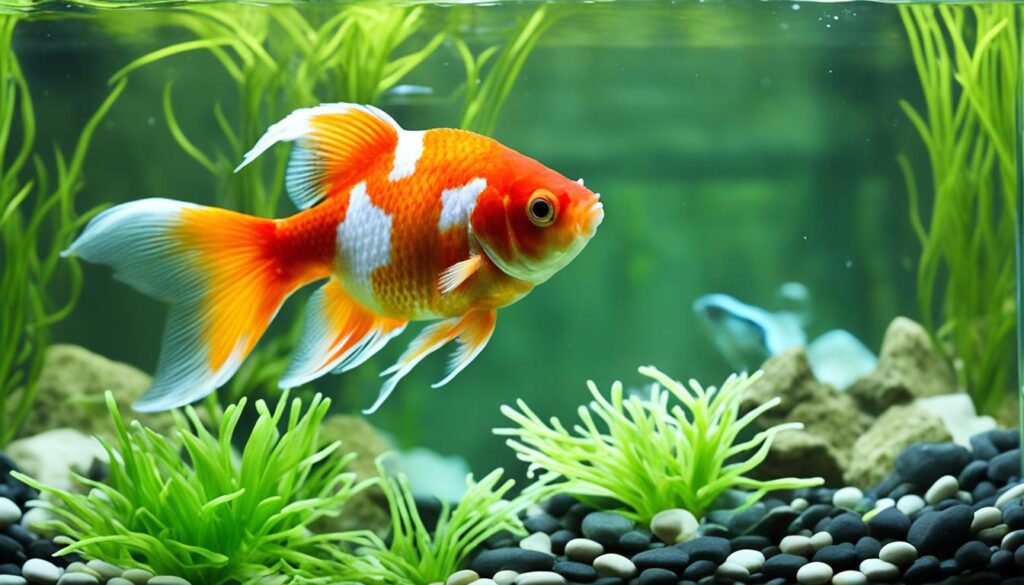
The Oranda Goldfish, with its vibrant colors and unique wen, shines among aquarium beauties. Their colors range from orange, black, to captivating deep blue. They also have distinctive body features that set them apart in the fancy goldfish varieties.
The wen is a special feature of the Oranda Goldfish. It starts showing between three to four months and takes one to two years to fully develop. This crest not only boosts their Oranda Goldfish appearance but also marks their health and vitality.
Feature |
Description |
|---|---|
Colors |
Varies from orange, black, blue, white, silver, matte, yellow to bronze |
Wen Development |
Starts around 3-4 months, fully forms by 1-2 years |
Size |
Can grow up to 12 inches depending on conditions |
Behavior |
Outgoing, can recognize and interact with owners |
Group Preference |
Thrives in groups of five or more for better socialization |
Fins |
Beautiful, quad-point caudal fins, perfect for graceful swimming |
The Oranda Goldfish has a graceful swim style and can bond with their owners. They are not just pets but companions in any tank. Adding these aquarium beauties to your tank makes it a natural art centerpiece. Caring for these fancy goldfish varieties is a rewarding hobby.
Oranda Goldfish Lifespan and Health
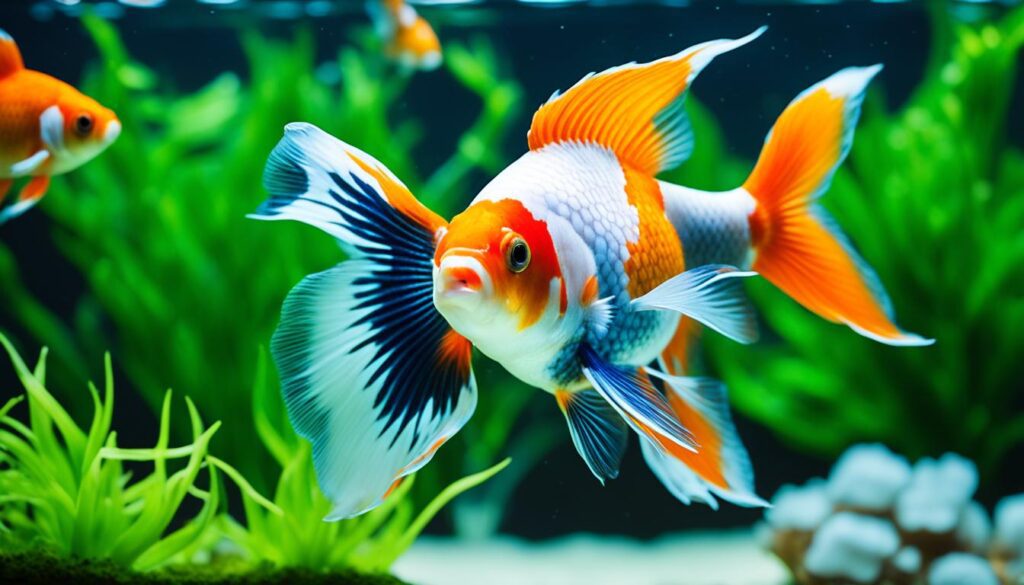
Learning about the Oranda Goldfish lifespan and goldfish health care is very important. When taken care of properly, these beautiful fish can live up to 15 years. To reach such an age, their diet, the water they live in, and their tank environment must be right.
Keeping the water in the best condition is key. Oranda Goldfish like water that’s between 65°F and 72°F. Checking and keeping the water clean can stop health problems like Ich. Ich, also known as white spot disease, can make these fish very stressed even though it’s treatable.
How much you feed them is also very important. Feeding them too much can pollute the water and cause sickness. It’s best to feed them little amounts two or three times a day. They should eat all their food in a few minutes to avoid leftovers and keep the tank clean.
Criteria |
Requirement |
|---|---|
Tank Size |
Minimum 20 gallons |
Temperature |
65°F to 72°F |
Daily Feeding |
2-3 times, small portions |
Common Health Issue |
Ich (White Spot Disease) |
Sociability |
Thrives in peaceful community setup |
Oranda Goldfish have special features like big fins and a unique head growth called wen. These features need extra care to avoid harming their health or sight. A big, clean tank is important for their health and aquatic longevity.
Good tank setup, water quality, and a right diet are crucial. Doing this helps your Oranda Goldfish live a long, healthy life. They’ll be a happy part of your aquatic world for many years.
Tank Considerations for Oranda Goldfish
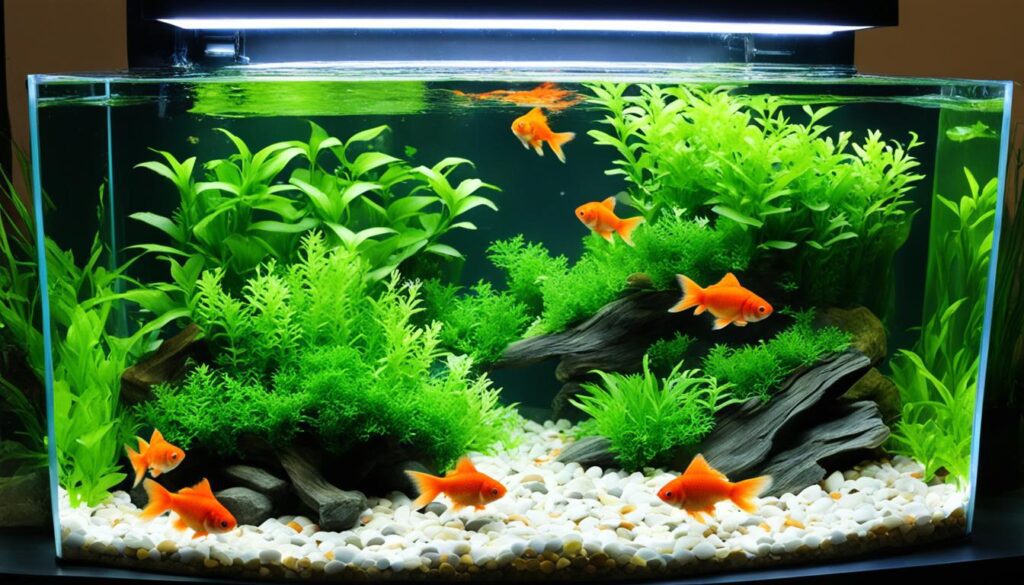
When setting up a tank for Oranda Goldfish, it’s key to know about aquarium sizing, water parameters, and tank aesthetics. These fish are not only beautiful but also have specific needs. Giving them the right home improves their life and your tank’s look.
Choosing the Right Tank Size
A 30-gallon tank is a good start for Oranda Goldfish. They need room to grow and move. Small tanks can cause health issues. For every extra fish, add 10 gallons. This keeps the water clean and healthy for them.
Water Quality and Parameter Guidelines
Keeping the water parameters right is key for Oranda Goldfish. They need a pH level between 6.0 and 8.0. The ideal water temperature is 65°F to 72°F. Check the water often to keep it clean and at the right pH and temperature. This helps them breathe and stay stress-free.
Suitable Decorations and Substrate Choices
Tank aesthetics matter for looks and goldfish care. Fine sand is safe for Orandas, preventing injuries. Use decorations that are smooth and plants that are sturdy. This prevents harm and keeps the tank safe and beautiful for them.
Here’s a simple table with the best aquarium setup for Oranda Goldfish:
Parameter |
Recommended Range |
Purpose |
|---|---|---|
Tank Size |
30 gallons + 10 gallons per additional fish |
Ensures space for growth and activity |
Temperature |
65°F to 72°F |
Optimal for health and digestion |
pH Level |
6.0 to 8.0 |
Maintains water quality and fish health |
Substrate |
Fine sand |
Prevents injuries and allows natural behavior |
By regularly checking and caring for their environment, your Oranda Goldfish will not only be healthy. They’ll also be more vibrant and fun to watch.
Understanding Oranda Goldfish Tank Setup
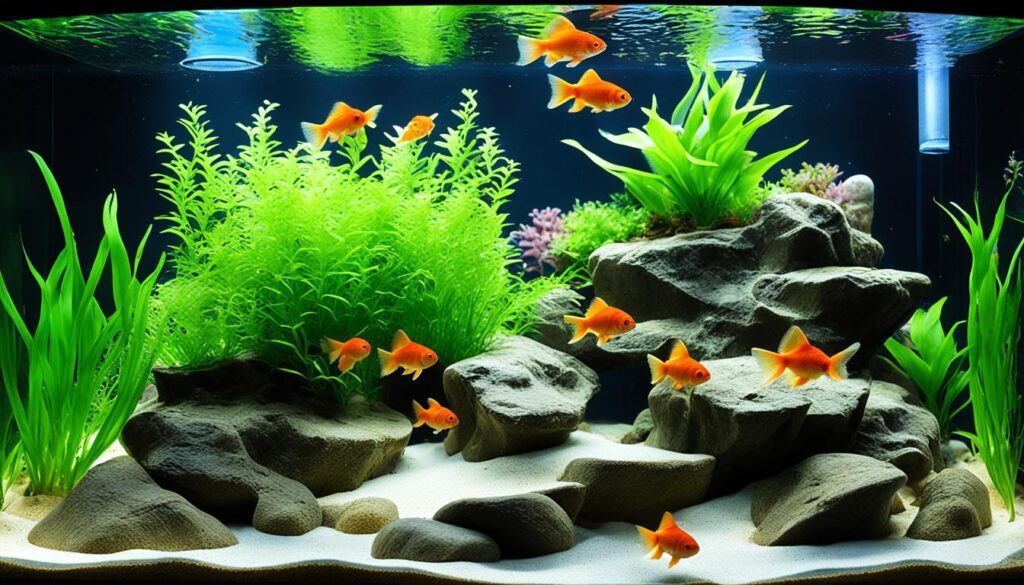
Setting up the right tank for Oranda Goldfish is very important. Their well-being depends on the environment we create for them. If we keep their space balanced, they live longer and stay healthy.
Choosing the right size tank for Oranda Goldfish is the first step. Here’s what they need to be happy:
Characteristic |
Requirement |
|---|---|
Minimum Tank Size |
30 gallons |
Temperature Range |
65-72°F |
pH Range |
6.0-8.0 |
Water Hardness (dGH) |
4-20 |
Weekly Water Change |
25-30% |
Having a top-notch filter is key for a clean home for Orandas. It’s wise to use two external filters. They handle the waste well, making the water clear and safe for the fish.
The choice of decorations is also crucial for their living space. Smooth substrates like fine gravel or sand are best. They won’t hurt their fins. Adding live plants is a good idea too. They make oxygen and provide hiding spots.
By focusing on these aspects, your Oranda Goldfish will flourish. It’s all about creating a supportive and engaging home for them.
Feeding Your Oranda Goldfish: A Guide to Nutrition and Diet
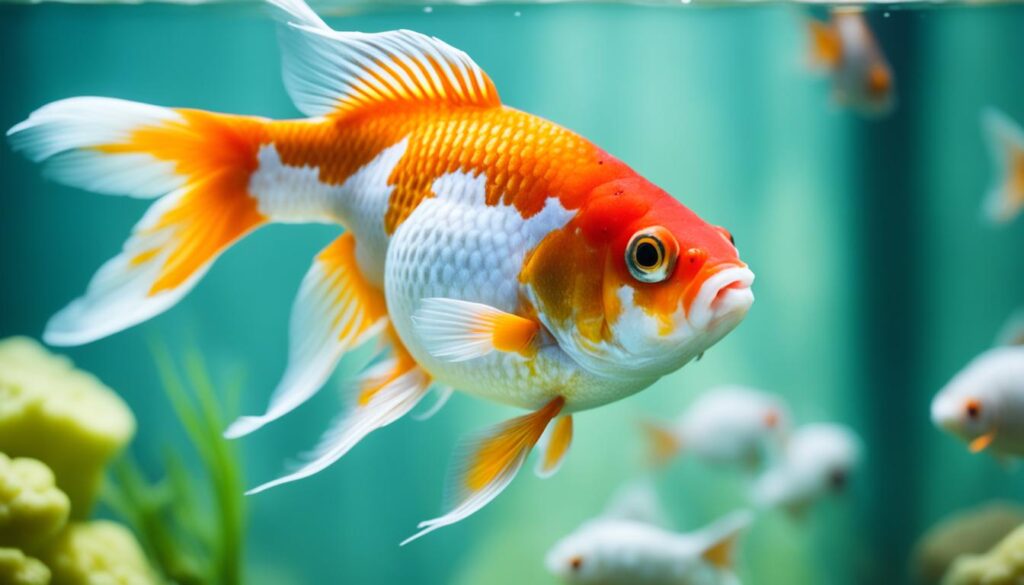
It’s key to know what your Oranda Goldfish needs to eat to stay healthy and colorful. They digest food differently because they don’t have a stomach. Food goes straight to their intestines. I have found, through experience, the right balance in their diet is vital.
Common Foods and Dietary Preferences
Oranda Goldfish enjoy a varied diet of plants and proteins. I suggest high-quality pellets, like Hikari Oranda Gold, for balanced nutrition. Soak dry pellets to make them easier to digest. This prevents swimming problems. Live and frozen foods, such as brine shrimp or bloodworms, provide required protein and encourage natural behaviors.
Vegetables are also important. Add spinach and shredded lettuce to their meals for fiber. This helps with digestion. I mix up their meals with both dry and fresh foods to meet their nutritional needs.
How Often to Feed Your Oranda Goldfish
Feed adult Oranda Goldfish once a day to avoid overfeeding. Each meal should be finished in two to three minutes. This prevents food waste that could spoil the water.
Adjust feeding habits to fit the fish’s needs and their environment. Reduce food in cooler weather to help with their slower metabolism. In warm weather, feed smaller, more frequent meals to promote growth and color. Watch how your fish react to their diet and make changes as needed. Clear feces after feeding suggest a well-managed diet.
Noticing how your fish reacts is crucial. This lets you tailor their feeding schedule. A balanced diet will help your Orandas thrive.
Nurturing the Social Aspect: Oranda Goldfish Behavior and Compatibility

Understanding the social temperament of Oranda Goldfish is key for anyone wanting a lively community tank. These fish are known for their unique, colorful look and peaceful nature. This makes them great with other compatible species.
Oranda Goldfish do well with other gentle fish that need the same kind of water and space. It’s important to find tank mates that match their peaceful ways and won’t beat them to food. Good partners are other fancy goldfish—like Ryukins, Fantails, and Black Moors. These fish have much in common, like how they swim and act.
Fish that live in different levels of water, such as White Cloud Mountain Minnows, are also fine choices. They add life and color to the tank without bothering the Orandas. Yet, it’s important to avoid fish that swim much faster or are small enough to be seen as food. This keeps the tank safe and peaceful.
Fish Type |
Compatibility with Oranda Goldfish |
Considerations |
|---|---|---|
Ryukins, Fantails, Black Moors |
Highly Compatible |
Similar care requirements and swimming ability |
White Cloud Mountain Minnows |
Compatible |
Different column dwellers; No competition for food |
Fast-swimming Fish |
Not Compatible |
Can stress Orandas by outcompeting them for food |
Smaller Fish (potential food size) |
Not Compatible |
Potential risk of being eaten by Orandas |
Keeping a balanced community tank with Oranda Goldfish means choosing the right compatible species and watching them closely. Make sure all fish have enough room and that the water is clean. With careful choices and care, your Oranda Goldfish will brighten the tank with their colors and behaviors in a happy water world.
Protecting Your Oranda Goldfish from Common Diseases
I love Oranda Goldfish and always work to keep them healthy. They can live for more than 30 years! It’s vital to know diseases like Ich, parasites, and swim bladder issues can affect them. Through my experience, I’ve found preventing diseases and regular care are key.
I ensure a safe home for my Orandas with the right tank conditions. The temperature is kept between 65–75 F. A strong filter keeps the water clean. I feed them well-balanced meals once a day using sinking foods. This helps avoid overeating and swim bladder problems. I change the water regularly and check the water quality every month.
Sometimes, despite all precautions, a fish might get sick. Quick action is important. I isolate sick fish and treat them promptly. For complicated issues, I consult with fish health experts. Noticing signs of trouble early and maintaining a healthy tank environment help my Orandas thrive.








